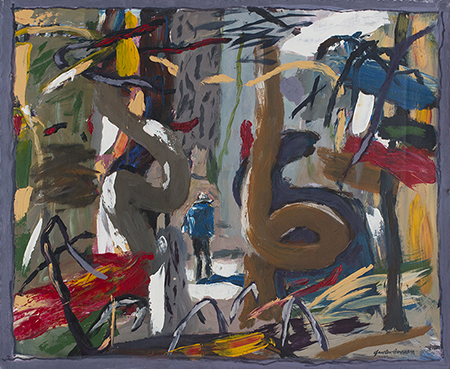
Continuing through June 30, 2023
At age 102, it’s hard to fault Gaylen Hansen for repeating himself or recycling earlier ideas: he’s had so many. His new works are his most vigorous paintings yet, however, fraught with a determined anger and courage that perfectly match his lifelong views on the endangered environment and the relationships between animals and humans. A few earlier oils are peppered into the mix here to help visitors new to his work learn how smooth and enclosed his imagery and touch once were.
Prophet of climate change, poet of the outdoors, twisted apostle of westward expansion, Hansen has played many roles in his long career. Since his Seattle debut in 1959, he has garnered worldwide acclaim by exploring his own backyard. Connected in some ways to San Francisco Bay Area funk artists such as William T. Wiley, Robert Arneson, and Roy de Forest (all of whom he knew), Hansen transcended their influences, as well as his youthful flirtation with Abstract Expressionism.
This new grouping consists of nine big oils on canvases and eight smaller ones, plus the five aforementioned earlier works. We can trace the locked-in elegance of “Woman and Yellow Fish” (1982) through the snarling dogs of the 1980s and 1990s, to the current agitated vistas of evergreen forests, a late development resulting from his move from eastern Washington to Whidbey Island north of Seattle. In every case, he depicts animals with personalities and humans with animal-like dilemmas. Man and animal co-exist in a seething or freezing climate, each encountering the other on the verge of extinction. Among these paintings, “Forest Walker,” “Fallen Tree,” and “Rider on White Horse” dazzle with slashes and gashes of brilliantly colored paint, light years away from the dry surfaces and mordant wit of his legendary earlier work.
One significant anointing of haute celebrity status was his inclusion in the 1979 “Sustained Visions” show at the New Museum by its controversial founding Director-Curator Marcia Tucker. From then on, Hansen was untouchable, free to expand and explore his own private Idaho with its tamed wildlife — bison, bears, wolves, buffalo, grasshoppers — not to mention wild domestic pets, including vicious cats, dogs, and dive-bombing birds. No Wild-West cliché was safe from his alteration, and each was transformed into a character in an ongoing narrative starring the artist’s personae of The Kernal and Mountain Man. Autobiographical, yes, but also universal and symbolic of the plight of humanity in a natural world going out of control.
“Two White Dogs,” “Red Dog,” and “Head of a Dog” are all terrifying with their white, sketchy outlines, as if they are dematerializing before our eyes. Ghost-like, they may prefigure their own extinction or immolation at the hands of global warming. Despite the changes, certain motifs and themes remain, only to be refined to the status of genius: the scalar disproportion between animals, insects and humans; Hansen’s refusal to sentimentalize or glamorize the tightly abbreviated scenery of the Pacific Northwest, Canada, or Idaho where he grew up on a farm before attending Otis Art Institute; and the persistent themes of inter-species sex and the instinct-driven pursuit of procreation in the animal world. Survival is equated with sex, as in “Two Dogs, One Green” (1984) with its erect genitalia and “Cosmic Dogs” (2021) where under the full moon one dog chases another with reddened tail gushing forth.
Besides the Bay Area artists, Hansen has paid his debt to older artists such as Henri Rousseau (Hansen did his own “Sleeping Gypsy”); Giorgio Morandi; and Philip Guston, whom he most resembles in his segmented compositions, smooth yet thick paint application, cartoonish figuration (which Hansen arrived at first), and autobiographical personae. Yet forsaking Guston’s urban angst, Hansen has explored four main categories, all set in a mythical, personal Far West: Nature at rest; Nature gone awry; Nature as threat to Man; and Man as threat to Nature. With enough vision and energy to fill a lifetime and more, the beloved centenarian shows no sign of exhausting or even depleting his internally driven vision of power mediated by humor and zest.
Soon after Hansen’s show, Linda Hodges Gallery will be closing after 40 years. A stalwart, Hodges became a home for regional artists making it big elsewhere (Hansen, Alfredo Arreguin), as well as a showcase for younger artists poised to break through, like Hollis Sigler, Jim Lutes, Andrea Joyce Heimer, and Theodore Waddell. Her presence and guidance, credibility and gracious personality, will be missed.
